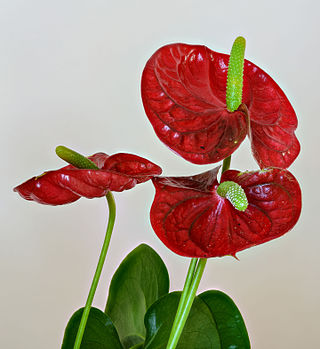
Anthurium is a genus of about 1,000 species of flowering plants, the largest genus of the arum family, Araceae. General common names include anthurium, tailflower, flamingo flower, and laceleaf.
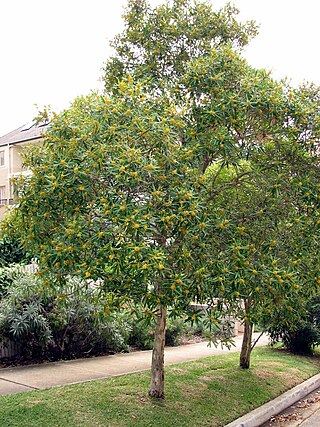
Tristaniopsis is a group of shrub and tree in the myrtle family Myrtaceae described as a genus in 1863. They have a wide distribution in Southeast Asia, New Guinea, New Caledonia and Australia.

Hanguana is a genus of flowering plants with a dozen known species. It is the only genus in the family Hanguanaceae.
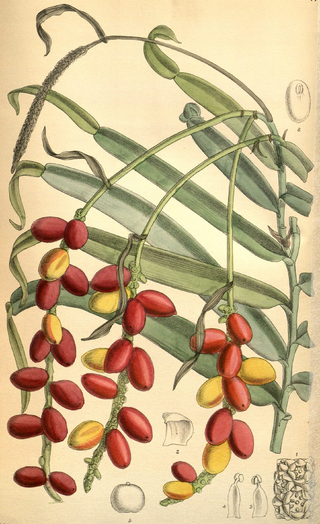
Pothos is a genus of flowering plants in the family Araceae. It is native to China, the Indian Subcontinent, Australia, New Guinea, Southeast Asia, and various islands of the Pacific and Indian Oceans.
Pholidocarpus is a genus of flowering plant in the family Arecaceae, native to Southeast Asia. It contains the following species:
Rhopaloblaste is a genus of flowering plant in the family Arecaceae, native to New Guinea, Melanesia and Southeast Asia.
Maxburretia is a genus of three rare species of palms found in southern Thailand and Peninsular Malaysia. The genus is named in honor of Max Burret, a German botanist.

Homalomena is a genus of flowering plants in the family Araceae. Homalomena are found in southern Asia and the southwestern Pacific. Many Homalomena have a strong smell of anise. The name derives apparently from a mistranslated Malayan vernacular name, translated as homalos, meaning flat, and mene = moon.
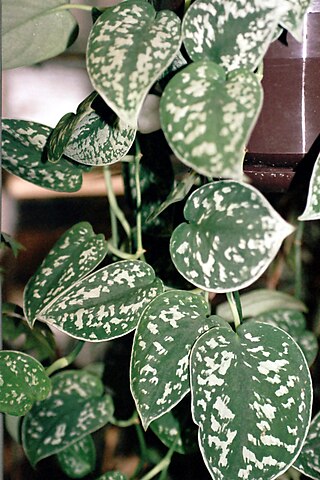
Scindapsus is a genus of flowering plants in the family Araceae. It is native to Southeast Asia, New Guinea, Queensland, and a few western Pacific islands. The species Scindapsus pictus is common in cultivation.
Amydrium is a genus of flowering plants in the family Araceae that is native to Southeast Asia, southern China, and New Guinea.
Anadendrum is a genus of flowering plants in the family Araceae. It is native to China and Southeast Asia.

Anaphyllum is a genus of flowering plants in the family Araceae. It consists of two species. They are found in marshes, have leaves with some pinnation, and have a twisted spathe. The two species in this genus are similar in appearance to those in the genus Anaphyllopsis.
- Anaphyllum beddomeiEngl. - Tamil Nadu, Lakshadweep
- Anaphyllum wightiiSchott. - Kerala, Lakshadweep
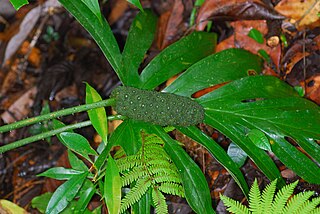
Lasia is a genus of flowering plants in the family Araceae, native to Asia and New Guinea. The genus contains only two known species, Lasia spinosa and Lasia concinna. Lasia was believed to be a monotypic genus until 1997 when a wild population of Lasia concinna was discovered in a farmer's paddy field in West Kalimantan, Indonesia. The farmer had been growing them for their edible young leaves. This species of Lasia had been known of previously only from a single specimen at the Bogor Botanic Gardens, formally described in 1920. Prior to 1997, the specimen was believed to have been a hybrid between Lasia spinosa and Cyrtosperma merkusii. The subsequent discovery by Hambali and Sizemore led to the realization that it was in fact a distinct species.
Podolasia is a monotypic genus of flowering plants in the family Araceae. The single known species in the genus is Podolasia stipitata. It is native to Borneo, Sumatra, and Peninsular Malaysia.

Piptospatha is a genus of flowering plants in the family Araceae. The genus is characteristic is rheophytic and has seeds that are dispersed by splashes of water hitting its cup-like spathes. It is native to Southeast Asia.
- Piptospatha burbidgei(N.E.Br.) M.Hotta - Sarawak, Sabah
- Piptospatha elongata(Engl.) N.E.Br. - Kalimantan Barat
- Piptospatha impolitaS.Y.Wong, P.C.Boyce & Bogner - Sarawak
- Piptospatha insignisN.E.Br. - Sarawak
- Piptospatha manduensisBogner & A.Hay - Kalimantan Timur
- Piptospatha marginata(Engl.) N.E.Br. - Sarawak
- Piptospatha perakensis(Engl.) Ridl. - southern Thailand, Peninsular Malaysia
- Piptospatha remiformisRidl. - Sarawak
- Piptospatha repensH.Okada & Tsukaya - Kalimantan Barat
- Piptospatha ridleyiN.E.Br. ex Hook.f. - Johor, Pahang, Selangor
- Piptospatha truncata(M.Hotta) Bogner & A.Hay - Sarawak
- Piptospatha viridistigmaS.Y.Wong, P.C.Boyce & Bogner - Sarawak
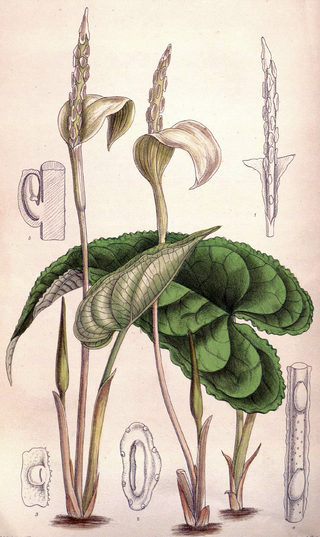
Hapaline is a genus of flowering plants in the family Araceae. It contains 7 species that are found from southern China to Borneo.

Holarrhena pubescens is a species of flowering plant in the family Apocynaceae. It is native to central and southern Africa, the Indian Subcontinent, Indochina, and parts of China. In Cambodia, it is called /tɨk dɑh kʰlaː thɔm/ ទឹកដោះខ្លាធំ big tiger milk or /kʰlaɛɲ kŭəŋ/ ខ្លែងគង់ invulnerable kite. These seeds are sold as indraja (इनद्राजा) for Ayurvedic medicine in India.
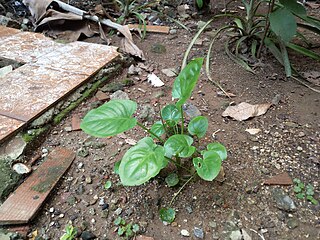
Typhonium flagelliforme is a species of flowering plant in the family Araceae.
Apoballis is a genus of plants in the Araceae. It is native to Southeast Asia, primarily the Island of Sumatra in Indonesia. Some authorities regard this group as part of the larger genus Schismatoglottis.
- Apoballis acuminatissima(Schott) S.Y.Wong & P.C.Boyce - Sumatra
- Apoballis belophylla(Alderw.) S.Y.Wong & P.C.Boyce - Sumatra
- Apoballis brevipes(Hook.f.) S.Y.Wong & P.C.Boyce - Sumatra, Thailand, Peninsular Malaysia
- Apoballis grandiflora(Alderw.) S.Y.Wong & P.C.Boyce - Sumatra
- Apoballis hastifolia(Hallier f. ex Engl.) S.Y.Wong & P.C.Boyce - Sumatra
- Apoballis javanica(Engl.) S.Y.Wong & P.C.Boyce - Java
- Apoballis longicaulis(Ridl.) S.Y.Wong & P.C.Boyce - Sumatra
- Apoballis mutata(Scort. ex Hook.f.) S.Y.Wong & P.C.Boyce - Myanmar, Sumatra, Thailand, Peninsular Malaysia
- Apoballis okadae(M.Hotta) S.Y.Wong & P.C.Boyce - Sumatra
- Apoballis ovata(Schott) S.Y.Wong & P.C.Boyce - Sumatra
- Apoballis rupestris(Zoll. & Moritzi) S.Y.Wong & P.C.Boyce - Sumatra, Java, Bali, Lombok, Timor
- Apoballis sagittifolia(Alderw.) S.Y.Wong & P.C.Boyce - Sumatra
Vesta is a genus of flowering plants in the family Araceae, formally described in 2018. It contains only one known species, Vesta longifolia, native to Perak in Peninsular Malaysia and to Brunei and Sarawak on the island of Borneo.












